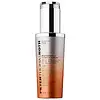What's inside
What's inside
 Key Ingredients
Key Ingredients

 Benefits
Benefits

 Concerns
Concerns

 Ingredients Side-by-side
Ingredients Side-by-side

Butyl Methoxydibenzoylmethane 3%
UV AbsorberHomosalate 9%
Skin ConditioningEthylhexyl Salicylate 5%
UV AbsorberOctocrylene 6%
UV AbsorberWater
Skin Conditioning3-O-Ethyl Ascorbic Acid
Skin ConditioningC13-15 Alkane
SolventGlycerin
HumectantPolyglyceryl-6 Polyricinoleate
EmulsifyingPolyglyceryl-6 Polyhydroxystearate
EmulsifyingOctyldodecyl Citrate Crosspolymer
HumectantNiacinamide
SmoothingPhenethyl Benzoate
EmollientPolyester-25
Skin ProtectingSilica
AbrasiveTerminalia Ferdinandiana Fruit Extract
AntioxidantRosa Centifolia Flower Extract
AstringentJasminum Officinale Flower Extract
MaskingBellis Perennis Flower Extract
Skin ConditioningHydrolyzed Sodium Hyaluronate
Skin ConditioningSodium Hyaluronate
HumectantPseudoalteromonas Ferment Extract
HumectantGlyceryl Caprylate
EmollientDisteardimonium Hectorite
StabilisingXanthan Gum
EmulsifyingPolyglyceryl-2 Isostearate
EmulsifyingMagnesium Sulfate
Sodium Chloride
MaskingCitric Acid
BufferingTrisodium Ethylenediamine Disuccinate
Sodium Citrate
BufferingPentylene Glycol
Skin ConditioningPropanediol
SolventCaprylyl Glycol
EmollientEthylhexylglycerin
Skin ConditioningChlorphenesin
AntimicrobialButyl Methoxydibenzoylmethane 3%, Homosalate 9%, Ethylhexyl Salicylate 5%, Octocrylene 6%, Water, 3-O-Ethyl Ascorbic Acid, C13-15 Alkane, Glycerin, Polyglyceryl-6 Polyricinoleate, Polyglyceryl-6 Polyhydroxystearate, Octyldodecyl Citrate Crosspolymer, Niacinamide, Phenethyl Benzoate, Polyester-25, Silica, Terminalia Ferdinandiana Fruit Extract, Rosa Centifolia Flower Extract, Jasminum Officinale Flower Extract, Bellis Perennis Flower Extract, Hydrolyzed Sodium Hyaluronate, Sodium Hyaluronate, Pseudoalteromonas Ferment Extract, Glyceryl Caprylate, Disteardimonium Hectorite, Xanthan Gum, Polyglyceryl-2 Isostearate, Magnesium Sulfate, Sodium Chloride, Citric Acid, Trisodium Ethylenediamine Disuccinate, Sodium Citrate, Pentylene Glycol, Propanediol, Caprylyl Glycol, Ethylhexylglycerin, Chlorphenesin
Water
Skin ConditioningTetrahexyldecyl Ascorbate
AntioxidantButylene Glycol
HumectantC9-12 Alkane
SolventCaprylyl Methicone
Skin ConditioningTocopheryl Acetate
AntioxidantC10-18 Triglycerides
EmollientPolyglyceryl-6 Distearate
EmulsifyingFerulic Acid
AntimicrobialSqualane
EmollientHydrogenated Lecithin
EmulsifyingPropanediol
SolventSodium Hyaluronate
HumectantZingiber Officinale Root Extract
MaskingCurcuma Longa Root Extract
MaskingPanax Ginseng Root Extract
EmollientJojoba Esters
EmollientLeuconostoc/Radish Root Ferment Filtrate
AntimicrobialCoco-Caprylate/Caprate
EmollientGlycerin
HumectantCetyl Alcohol
EmollientPolyglyceryl-3 Beeswax
EmulsifyingXanthan Gum
EmulsifyingDisodium EDTA
Mica
Cosmetic ColorantEthylhexylglycerin
Skin ConditioningPotassium Sorbate
PreservativeSodium Benzoate
MaskingPhenoxyethanol
PreservativeWater, Tetrahexyldecyl Ascorbate, Butylene Glycol, C9-12 Alkane, Caprylyl Methicone, Tocopheryl Acetate, C10-18 Triglycerides, Polyglyceryl-6 Distearate, Ferulic Acid, Squalane, Hydrogenated Lecithin, Propanediol, Sodium Hyaluronate, Zingiber Officinale Root Extract, Curcuma Longa Root Extract, Panax Ginseng Root Extract, Jojoba Esters, Leuconostoc/Radish Root Ferment Filtrate, Coco-Caprylate/Caprate, Glycerin, Cetyl Alcohol, Polyglyceryl-3 Beeswax, Xanthan Gum, Disodium EDTA, Mica, Ethylhexylglycerin, Potassium Sorbate, Sodium Benzoate, Phenoxyethanol
 Reviews
Reviews

Ingredients Explained
These ingredients are found in both products.
Ingredients higher up in an ingredient list are typically present in a larger amount.
Ethylhexylglycerin (we can't pronounce this either) is commonly used as a preservative and skin softener. It is derived from glyceryl.
You might see Ethylhexylglycerin often paired with other preservatives such as phenoxyethanol. Ethylhexylglycerin has been found to increase the effectiveness of these other preservatives.
Glycerin is already naturally found in your skin. It helps moisturize and protect your skin.
A study from 2016 found glycerin to be more effective as a humectant than AHAs and hyaluronic acid.
As a humectant, it helps the skin stay hydrated by pulling moisture to your skin. The low molecular weight of glycerin allows it to pull moisture into the deeper layers of your skin.
Hydrated skin improves your skin barrier; Your skin barrier helps protect against irritants and bacteria.
Glycerin has also been found to have antimicrobial and antiviral properties. Due to these properties, glycerin is often used in wound and burn treatments.
In cosmetics, glycerin is usually derived from plants such as soybean or palm. However, it can also be sourced from animals, such as tallow or animal fat.
This ingredient is organic, colorless, odorless, and non-toxic.
Glycerin is the name for this ingredient in American English. British English uses Glycerol/Glycerine.
Learn more about GlycerinPropanediol is an all-star ingredient. It softens, hydrates, and smooths the skin.
It’s often used to:
Propanediol is not likely to cause sensitivity and considered safe to use. It is derived from corn or petroleum with a clear color and no scent.
Learn more about PropanediolSodium Hyaluronate is hyaluronic acid's salt form. It is commonly derived from the sodium salt of hyaluronic acid.
Like hyaluronic acid, it is great at holding water and acts as a humectant. This makes it a great skin hydrating ingredient.
Sodium Hyaluronate is naturally occurring in our bodies and is mostly found in eye fluid and joints.
These are some other common types of Hyaluronic Acid:
Learn more about Sodium HyaluronateWater. It's the most common cosmetic ingredient of all. You'll usually see it at the top of ingredient lists, meaning that it makes up the largest part of the product.
So why is it so popular? Water most often acts as a solvent - this means that it helps dissolve other ingredients into the formulation.
You'll also recognize water as that liquid we all need to stay alive. If you see this, drink a glass of water. Stay hydrated!
Learn more about WaterXanthan gum is used as a stabilizer and thickener within cosmetic products. It helps give products a sticky, thick feeling - preventing them from being too runny.
On the technical side of things, xanthan gum is a polysaccharide - a combination consisting of multiple sugar molecules bonded together.
Xanthan gum is a pretty common and great ingredient. It is a natural, non-toxic, non-irritating ingredient that is also commonly used in food products.
Learn more about Xanthan Gum